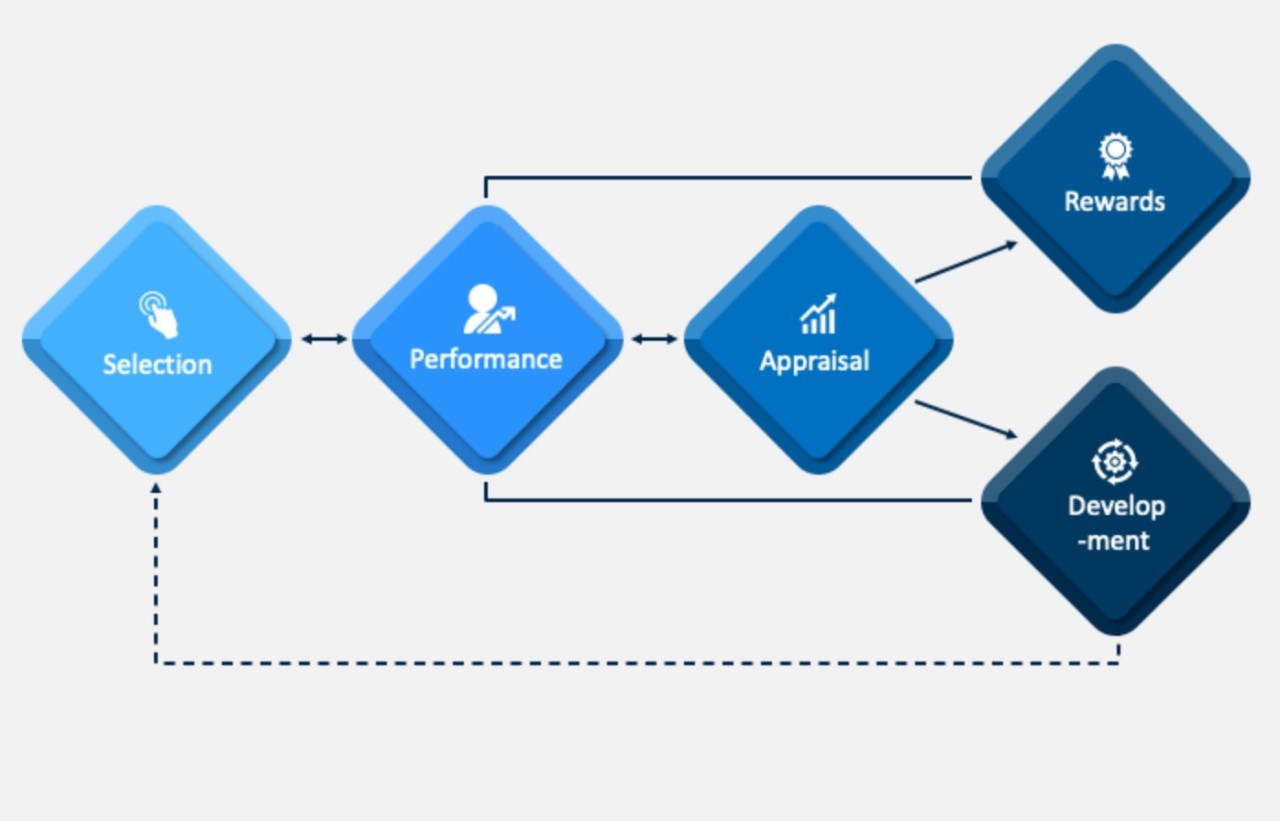Insight Blog
Agility’s perspectives on transforming the employee's experience throughout remote transformation using connected enterprise tools.
7 minutes reading time
(1457 words)
5P Model of SHRM – UPDATED 2022 – A Complete Guide
As its name suggests, The 5P's Model is based on five constitutional aspects: purpose, principles, processes, people, and performance
Managing a company's human resources in accordance with the company's long-term strategy is called strategic human resource management. Strategic HR management's goal is to accomplish the following:
Boost agility, innovation, and competitiveness by implementing these strategies. It is also important to develop an organizational culture that is appropriate for the job and boosts the efficiency of the company's operations.
Human resources (HR) must play an important role as a strategic partner in the development and implementation of company policies. Hiring, training, and rewarding staff are all examples of how strategic HR can be displayed.
In order to have a positive impact on a company's success, human resources must be strategically considered. The company's long-term goals necessitate a comprehensive approach to staff development and retention.
Many businesses find it difficult to get their HR affairs under control; there is a slew of various components that can cause owners to lose their bearings and make bad judgments that bog down both their employees and their company's operations.
5P Model of SHRM
The 5-P model of HRM was developed by Schulcr (1992) and describes how HRM works under the following headings:
An organization's HR philosophy explains how it treats and manages its human resources, and how important they are to its overall success.
HR policies lay down the ground rules for addressing issues pertaining to human resources in business, as well as for formulating HR plans and procedures in light of the organization's long-term goals.
As a result of HR regulations, these programs include coordinated HR activities that are meant to initiate and manage organizational transformation efforts based on strategic business goals.
In order to implement HR policies and programs, HR practices are necessary. Resources, training, reward and recognition, and relations with employees are a few of the many facets of HR that fall under this umbrella term. Lastly, it is through HR processes that HR strategic plans and policies are implemented.
Managing a company's human resources in accordance with the company's long-term strategy is called strategic human resource management. Strategic HR management's goal is to accomplish the following:
Increase your ability to adapt and innovate, as well as your competitive edge.
Develop an organizational culture that is appropriate for the job.
Boost the efficiency of the company's operations.
Human resources (HR) must play an important role as a strategic partner in the development and implementation of company policies. Employee recruitment, training, and compensation are all examples of strategic HR.
In order to have a positive impact on a company's success, human resources must be strategically considered. The company's long-term goals necessitate a comprehensive approach to staff development and retention.
Many businesses find it difficult to get their HR affairs under control; there is a slew of various components that can cause owners to lose their bearings and make bad judgments that bog down both their employees and their company's operations.
When an HR department practices strategic human resource management, it does not operate in a vacuum; instead, it collaborates with other divisions to learn about their goals and develop plans that are in line with both their and the company. Consequently, human resource departments' aims mirror and support the overall organization's goals. Strategy for human resources management (HRM) has evolved from its traditional role as an administrative burden to one that contributes to the success of an organization. Strategic HRM makes the most of the skills and resources in the human resources department in order to strengthen and improve the performance of other departments.
What is the significance of strategic human resources management?
To be successful, a company must have all of its employees working toward the same goal. As part of Strategic HR, personnel is analyzed and their value to the firm is determined. Sophisticated HR techniques are developed based on the findings of this investigation.
5P Model of HRM
Randall S. Schuler, a well-known academic in the fields of global HRM, strategic HRM, the role of HRM in organizations, and the intersection of corporate strategy and HRM, developed the 5P's HRM Model in 1992.
The 5P Model is founded on five fundamental principles: purpose, principles, procedures, people, and performance. When these five guiding principles are properly aligned and balanced, a company is more likely to succeed.
M. G. Pryor's 5P Model, developed in 1998 by C. White, M. White, and L. Toombs, has the same components as Pryor's model. The system is prompted by strategy, which in turn affects employee behavior, which in turn triggers performance.
Organizational performance is directly linked to employee performance and guided by the organization's aims and principles, according to the 5P's HRM Model.
Strategic HRM Models
An organization's strategy for managing and coordinating business tasks related to human capital is called an HRM model (or HR framework).
HRM models are designed to help firms manage their workforces in the most efficient and effective manner possible, in order to meet their stated goals.
A common way to describe human resource management is as a notion with two distinct approaches or forms. The emphasis on performance management and the instrumental approach to employee management characterizes a harsh approach to human resources management.
On the other hand, a "soft" approach to HRM concentrates on employee empowerment, motivation, and trust, deeming individual contributors to be the most valuable resource an organization can have.
Soft and hard HRM principles are typically combined in HRM models, although one of these techniques is given greater weight than the other. The following are the five most important HRM models that every HR professional should be familiar with.
Harvard Model of HRM
It was in 1984 at Harvard University when a group of specialists led by Michael Beer created one of the most significant and influential models of human resources management (HRM). Stakeholder interests, HR policies, HR outcomes, and the long-term implications the organization is aiming to achieve are all part of the Harvard Model's five major components.
This HR model holds that the relationship between the circumstances and the interests of stakeholders has a significant impact on and contributes to the formulation of HRM policies that should be executed in order to achieve the intended HR outcomes (commitment, competence, congruence, and cost-effectiveness).
Aiming to increase these four Cs will have positive effects on individual well-being, social well-being, and organizational effectiveness, according to the authors of this HRM paradigm.
The Harvard Model encourages general managers to become more active in the company's human resources department by providing them with the tools and resources they need to do so.
Based on the concept that human resources may be a substantial competitive advantage for any organization and so should be valued as assets rather than costs.
Michigan Model of HRM
'Hard' HRM refers to an approach that views employees as a resource to be used in a calculated and rational manner in order to achieve the organization's strategic goals. Human resources management (HRM) is more concerned with maximizing an organization's competitive advantage than it is with ensuring that its employees are happy and productive.
The HRM practices such as selection, assessment, rewards, and development can take on a variety of styles depending on the company's strategy and the structure of the organization. Companies with a traditional functional structure (i.e., organized according to the various business functions – finance, accounting, marketing, sales, and production), such as a single-product manufacturer will hire employees based on their specialization in the various business functions, for example.
For the most part, the evaluation of employee performance will be informal and conducted by personal contact; the reward system will vary unsystematically between functions, and employee development will be limited mostly to their functional area of work. However, a corporation with a multi-divisional structure and product diversification strategy may have a totally different HRM system. We'd use a methodical approach based on a candidate's functional expertise as well as their overall managerial potential.
Quantitative measures such as output and ROI would be combined with qualitative, subjective evaluations of individual performance to create a formal and impersonal evaluation system. Profitability targets may be tied to bonuses, which would incentivize employees to contribute to the company's diversification strategy. In a company with a multi-product strategy, employee development would be more complicated and structured. Employees in the multi-divisional organization are used to being rotated between different departments and functions on a regular basis. Cross-divisional, cross-subsidiary, and corporate growth of individuals are possible.
Categories
Blog
(2616)
Business Management
(320)
Employee Engagement
(210)
Digital Transformation
(174)
Growth
(119)
Intranets
(119)
Remote Work
(61)
Sales
(48)
Collaboration
(37)
Culture
(29)
Project management
(29)
Customer Experience
(26)
Knowledge Management
(21)
Leadership
(20)
Comparisons
(6)
News
(0)
Ready to learn more? 👍
One platform to optimize, manage and track all of your teams. Your new digital workplace is a click away. 🚀
Free for 14 days, no credit card required.

















